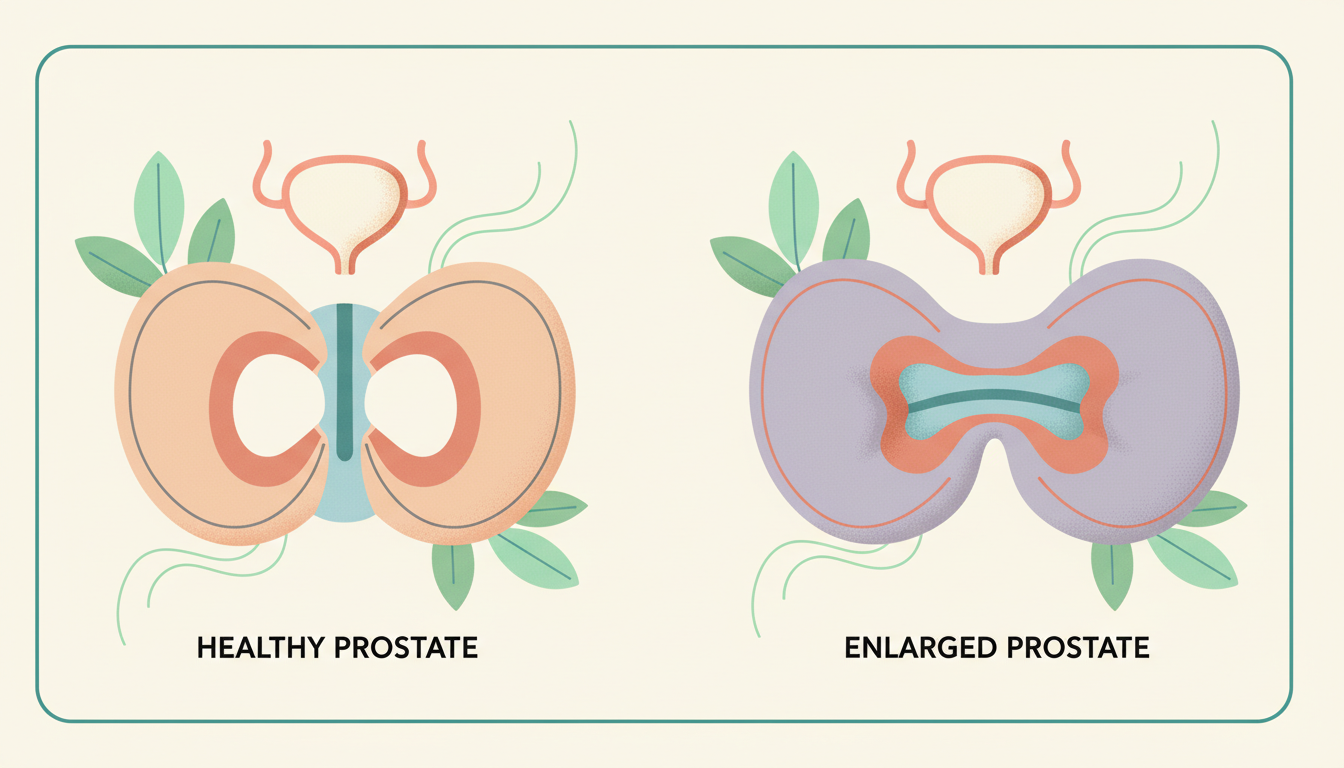Saw Palmetto and Prostate Health: A Deep Dive into Natural Support
Saw Palmetto and Prostate Health: A Deep Dive into Natural Support

Saw Palmetto, derived from the berries of the Serenoa repens palm, has long been explored as a natural remedy for men's prostate health. This comprehensive article delves into the scientific evidence supporting Saw Palmetto's use, particularly in the context of benign prostatic hyperplasia (BPH), a common condition affecting older men. We will explore its traditional applications, understand its proposed mechanisms of action, critically examine the findings from various clinical studies, and discuss its overall efficacy, safety profile, and practical considerations for those seeking natural support for urinary symptoms. Our goal is to provide a balanced, evidence-based perspective to help you make informed decisions about this widely used botanical supplement.
Understanding Benign Prostatic Hyperplasia (BPH)
Benign Prostatic Hyperplasia, commonly known as BPH, is a non-cancerous enlargement of the prostate gland. This condition is incredibly common, affecting approximately half of men between the ages of 51 and 60, and up to 90% of men over 80. As the prostate gland, which surrounds the urethra, grows larger, it can press on the urethra, leading to a variety of bothersome urinary symptoms.
These symptoms, often referred to as Lower Urinary Tract Symptoms (LUTS), can significantly impact a man's quality of life. They typically include increased urinary frequency, especially at night (nocturia), an urgent need to urinate, a weak or interrupted urine stream, difficulty starting urination, and the sensation of incomplete bladder emptying. While not life-threatening, BPH symptoms can be uncomfortable, disruptive, and lead to complications if left unmanaged, such as urinary tract infections or bladder stones.

What is Saw Palmetto? A Botanical Overview
Saw Palmetto (Serenoa repens) is a small palm tree native to the southeastern United States, particularly Florida and other coastal regions. For centuries, Native American tribes used its berries for food and medicinal purposes, including treating urinary and reproductive issues in men. The therapeutic properties of Saw Palmetto are primarily attributed to the extract derived from its ripe berries.
This extract is rich in various active compounds, including fatty acids (such as lauric acid, myristic acid, and oleic acid), phytosterols (like beta-sitosterol, campesterol, and stigmasterol), and flavonoids. These compounds are believed to work synergistically to exert their effects on the prostate gland. It's crucial that Saw Palmetto supplements are standardized to contain a specific percentage of these active fatty acids, typically 85-95%, to ensure consistent potency and effectiveness in clinical applications. This standardization helps guarantee that the consumer receives a consistent dose of the beneficial compounds, which can vary widely in unstandardized preparations.
How Saw Palmetto Supports Prostate Health
The potential benefits of Saw Palmetto for prostate health stem from several proposed mechanisms of action. These mechanisms collectively aim to address the underlying factors contributing to prostate enlargement and the associated urinary symptoms. Understanding these pathways helps explain why this botanical extract has garnered attention as a natural intervention. While research is ongoing, key theories revolve around hormonal regulation, anti-inflammatory effects, and muscle relaxation.
Hormonal Modulation
Inhibition of 5-alpha-reductase
One of the most well-studied mechanisms of Saw Palmetto involves its ability to inhibit the enzyme 5-alpha-reductase. This enzyme plays a crucial role in converting testosterone, a primary male hormone, into dihydrotestosterone (DHT). DHT is a more potent androgen that is strongly implicated in the growth and development of the prostate gland. By inhibiting 5-alpha-reductase, Saw Palmetto may reduce the amount of DHT available to prostate cells, potentially slowing prostate growth or even leading to a slight reduction in prostate size in some individuals. This mechanism is similar to that of certain prescription medications used for BPH, such as finasteride and dutasteride, though Saw Palmetto is believed to have a milder effect and a different safety profile.
Anti-inflammatory Properties
Reducing Prostate Inflammation
Inflammation is increasingly recognized as a significant factor in the progression of BPH and the severity of its symptoms. Saw Palmetto extract contains compounds that exhibit anti-inflammatory properties. It is thought to reduce the production of certain inflammatory mediators, such as prostaglandins and leukotrienes, within the prostate tissue. By mitigating inflammation, Saw Palmetto may help alleviate swelling and discomfort in the prostate, thereby reducing pressure on the urethra and improving urinary flow. This anti-inflammatory action could contribute to symptom relief independently of, or in conjunction with, its hormonal effects.
Anti-androgenic Effects
Blocking Androgen Receptors
Beyond inhibiting DHT production, some research suggests that Saw Palmetto may also directly interfere with the binding of DHT to androgen receptors in prostate cells. By blocking these receptors, Saw Palmetto could prevent DHT from stimulating prostate cell growth, even if DHT levels are present. This dual action—reducing DHT and blocking its effects—provides a comprehensive approach to managing prostate enlargement. However, the extent and significance of this direct receptor-blocking effect are still areas of active research.
Key Mechanism Alert: DHT and Prostate Growth
Dihydrotestosterone (DHT) is a potent hormone derived from testosterone. High levels of DHT in the prostate are strongly linked to prostate cell proliferation and the enlargement seen in BPH. Saw Palmetto's ability to interfere with DHT production and action is central to its proposed benefits for prostate health.
The Evidence: What Research Says About Saw Palmetto's Efficacy
The scientific community has conducted numerous studies on Saw Palmetto for BPH, yielding a complex and sometimes conflicting body of evidence. Early studies, particularly those conducted in Europe, often showed promising results, suggesting that Saw Palmetto could significantly improve urinary symptoms and flow rates in men with mild to moderate BPH. These studies frequently reported fewer side effects compared to conventional medications.
However, larger, more rigorous, and longer-term trials, particularly those sponsored by the National Institutes of Health (NIH) in the United States, have presented a more nuanced picture. The TRAMS (Prostate Research with Saw Palmetto) study, for instance, found that Saw Palmetto extract was no more effective than placebo in reducing urinary symptoms associated with BPH over a one-year period, even at higher doses. Subsequent meta-analyses, which combine data from multiple studies, have also produced mixed conclusions, with some indicating modest benefits comparable to placebo or very slight improvements, while others suggest it may be helpful for certain subsets of patients or for specific symptom profiles.
Discrepancies in research findings can often be attributed to several factors: variations in the quality and standardization of Saw Palmetto extracts used, differences in study design, duration, dosage, and the severity of BPH symptoms in the enrolled participants. It is important to note that while Saw Palmetto has been shown to improve subjective urinary symptoms for some men, it has generally not been found to significantly reduce prostate size. Many researchers suggest that any benefits observed may be more related to its anti-inflammatory properties and its ability to relax smooth muscle in the prostate and bladder neck, thereby improving urinary flow, rather than a direct reduction in prostate volume. When considering Saw Palmetto, it's crucial to weigh the evidence and discuss it with a healthcare professional, especially given the variability in study outcomes and the availability of proven medical therapies for BPH.

Dosage, Forms, and Important Considerations
When considering Saw Palmetto, the form and dosage are crucial for potential effectiveness. Most clinical studies that showed positive results utilized a liposterolic extract of Saw Palmetto, typically standardized to contain 85-95% fatty acids and phytosterols. A common daily dosage in these studies was around 320 mg, often taken once daily or split into two doses. It's important to choose a reputable brand that specifies its extract's standardization to ensure you are getting a consistent and potent product.
Saw Palmetto is available in various forms, including capsules, softgels, and sometimes as a liquid extract. While some individuals might consider raw berries or teas, the concentrated liposterolic extract is the form that has been most extensively studied for BPH.
Before starting any supplement, especially for a condition like BPH, it is essential to consult with a healthcare provider. They can accurately diagnose your symptoms, rule out more serious conditions (like prostate cancer), and discuss whether Saw Palmetto is an appropriate option for you, considering your overall health, existing medications, and the severity of your symptoms. Saw Palmetto should not be used as a substitute for regular medical check-ups or prescribed treatments for prostate issues.
Safety Profile and Potential Side Effects
Saw Palmetto is generally considered well-tolerated by most individuals when taken at recommended dosages. The incidence of side effects is relatively low and typically mild. The most commonly reported side effects include:
- Gastrointestinal discomfort: Mild stomach upset, nausea, or diarrhea. Taking the supplement with food can often mitigate these issues.
- Headache
- Dizziness
Serious side effects are rare. However, there are some important considerations regarding potential interactions and contraindications:
- Blood Thinners: There's a theoretical concern that Saw Palmetto might have mild anti-platelet effects, potentially increasing the risk of bleeding when taken with anticoagulant medications (blood thinners) like warfarin, aspirin, or clopidogrel. While clinical evidence for this interaction is limited and inconsistent, caution is advised.
- Hormone Therapies: Due to its potential hormonal modulating effects, Saw Palmetto might theoretically interact with hormone-based medications, including oral contraceptives or hormone replacement therapy.
- Pregnancy and Breastfeeding: Saw Palmetto is not recommended for pregnant or breastfeeding women due to its hormonal effects. It should also be avoided by children.
Always inform your doctor about all supplements and medications you are taking to ensure safe and effective management of your health. Discontinue use and seek medical advice if you experience any concerning or severe side effects.
Important: Always Consult Your Doctor
While Saw Palmetto is a natural supplement, it's not without potential effects or interactions. Always consult your physician before starting any new supplement, especially if you have an existing medical condition, are taking other medications, or are experiencing persistent urinary symptoms.
Frequently Asked Questions
The time frame for experiencing benefits from Saw Palmetto can vary greatly among individuals. Some men report improvements within a few weeks, while others may need to take it consistently for several months (typically 1 to 3 months) before noticing significant changes in their urinary symptoms. Consistent daily use as directed is generally recommended for optimal results.
While some early studies suggested a potential for modest prostate size reduction due to its DHT-inhibiting properties, most large, rigorous clinical trials have not consistently demonstrated that Saw Palmetto significantly shrinks the prostate gland. Its primary perceived benefits often relate to alleviating urinary symptoms rather than altering prostate volume. Conventional medications like 5-alpha-reductase inhibitors are more reliably used for prostate shrinkage.
Yes, there are potential interactions. Saw Palmetto may theoretically interact with blood-thinning medications (anticoagulants/antiplatelets) due to a possible, though unconfirmed, anti-platelet effect, increasing bleeding risk. It may also interfere with hormone therapies, including oral contraceptives, due to its hormone-modulating properties. Always consult your doctor or pharmacist about all medications and supplements you are taking to avoid adverse interactions.
No, Saw Palmetto is not universally effective for all men with BPH. Research results are mixed, with some individuals reporting significant relief and others experiencing little to no benefit, sometimes similar to a placebo. Its efficacy may depend on the individual's specific symptoms, the severity of their condition, the quality of the supplement, and underlying physiological factors. It is generally considered most effective for mild to moderate BPH symptoms.
The most effective form of Saw Palmetto is generally considered to be a liposterolic extract, standardized to contain 85-95% fatty acids and phytosterols. This is the form most commonly used in clinical studies that showed positive outcomes. Ensure the product you choose specifies this standardization on its label. Capsules or softgels are common delivery methods for these extracts.
Summary: Key Takeaways on Saw Palmetto for Prostate Health
Saw Palmetto remains a popular herbal remedy for men seeking natural support for prostate health, particularly for managing symptoms associated with benign prostatic hyperplasia (BPH). While the scientific evidence is extensive, it offers a mixed but generally encouraging picture for its role in alleviating lower urinary tract symptoms. Here are the key points to remember:
- Traditional Use: Saw Palmetto has a long history of traditional use for urinary and reproductive issues, deriving its beneficial compounds from the berries of the Serenoa repens palm.
- Mechanisms of Action: Its primary proposed actions involve inhibiting the enzyme 5-alpha-reductase (reducing DHT conversion), possessing anti-inflammatory properties, and potentially blocking androgen receptors in prostate cells. These mechanisms aim to reduce prostate growth signals and lessen inflammation.
- Efficacy: Clinical research has yielded mixed results. Earlier studies often showed positive outcomes for improving urinary flow and reducing frequency, urgency, and nocturia. However, larger, more recent trials have sometimes shown effects comparable to placebo, highlighting the importance of standardized extracts and individual variability. It's generally more effective for symptom relief than for significantly shrinking prostate size.
- Safety Profile: Saw Palmetto is typically well-tolerated, with mild side effects such as stomach upset, headache, or dizziness being the most common. Serious side effects are rare.
- Considerations for Use: Always choose a high-quality, standardized liposterolic extract (85-95% fatty acids). It is crucial to consult a healthcare provider before starting Saw Palmetto, especially if you have BPH symptoms, are on other medications, or have underlying health conditions, to ensure proper diagnosis and avoid potential interactions.
- Natural Support, Not a Cure: Saw Palmetto can be a valuable part of a holistic approach to prostate health for some men, but it should not replace conventional medical advice, diagnosis, or treatment for BPH or other prostate conditions.